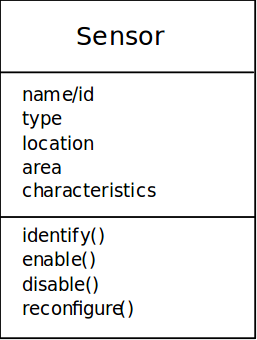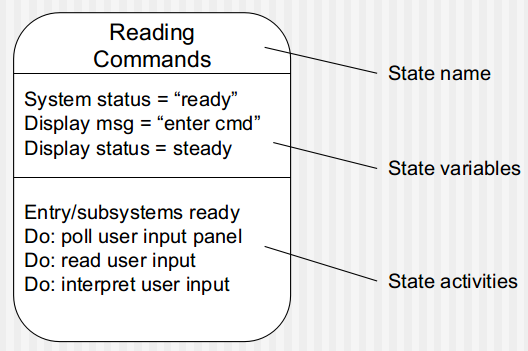26/11/2018, 22:12
Understanding Software Requirements
Requirements Engineering Inception : ask a set of questions that establis basic understanding of the problem the people who want a solution the nature of the solution that is desired, and the effectiveness of preliminary communication and collaboration between the customer and the ...
Requirements Engineering
- Inception: ask a set of questions that establis
- basic understanding of the problem
- the people who want a solution
- the nature of the solution that is desired, and
- the effectiveness of preliminary communication and collaboration between the customer and the developer
- Elicitation: elicit requirements from all stakeholders
- Elaboration: create an analysis model that identifies data, function and behavioral requirements
- Negotiation: agree on a deliverable system that is realistic for developers and customers
- Specification: can be any one (or more) of the following
- A written document
- A set of models
- A formal mathematical
- A collection of user scenarios (use-cases)
- A prototype
- Validation: a review mechanism that looks for
- errors in content or interpretation
- areas where clarification may be required
- missing information
- inconsistencies (a major problem when large products or systems are engineered)
- conflicting or unrealistic (unachievable) requirements.
Inception
- Identify stakeholders
- “who else do you think I should talk to?”
- Recognize multiple points of view
- Work toward collaboration
- The first questions
- Who is behind the request for this work?
- Who will use the solution?
- What will be the economic benefit of a successful solution
- Is there another source for the solution that you need?
Eliciting Requirements
- meetings are conducted and attended by both software engineers and customers
- rules for preparation and participation are established
- an agenda is suggested
- a "facilitator" (can be a customer, a developer, or an outsider) controls the meeting
- a "definition mechanism" (can be work sheets, flip charts, or wall stickers or an electronic bulletin board, chat room or virtual forum) is used
- the goal is
- to identify the problem
- propose elements of the solution
- negotiate different approaches, and
- specify a preliminary set of solution requirements

Elicitation Work Products
- a statement of need and feasibility.
- a bounded statement of scope for the system or product.
- a list of customers, users, and other stakeholders who participated in requirements elicitation
- a description of the system’s technical environment.
- a list of requirements (preferably organized by function) and the domain constraints that apply to each.
- a set of usage scenarios that provide insight into the use of the system or product under different operating conditions.
- any prototypes developed to better define requirements.
Building the Analysis Model
- Elements of the analysis model
- Scenario-based elements
- Functional—processing narratives for software functions
- Use-case—descriptions of the interaction between an “actor” and the system
- Class-based elements
- Implied by scenarios
- Behavioral elements
- State diagram
- Flow-oriented elements
- Data flow diagram
- Scenario-based elements
Use-Cases
- A collection of user scenarios that describe the thread of usage of a system
- Each scenario is described from the point-of-view of an “actor”—a person or device that interacts with the software in some way
- Each scenario answers the following questions:
- Who is the primary actor, the secondary actor (s)?
- What are the actor’s goals?
- What preconditions should exist before the story begins?
- What main tasks or functions are performed by the actor?
- What extensions might be considered as the story is described?
- What variations in the actor’s interaction are possible?
- What system information will the actor acquire, produce, or change?
- Will the actor have to inform the system about changes in the external environment?
- What information does the actor desire from the system?
- Does the actor wish to be informed about unexpected changes?
Use-Case Diagram

Class Diagram

State Diagram

Negotiating Requirements
- Identify the key stakeholders
- These are the people who will be involved in the negotiation
- Determine each of the stakeholders “win conditions”
- Win conditions are not always obvious
- Negotiate
- Work toward a set of requirements that lead to “win-win”
Validating Requirements
- Is each requirement consistent with the overall objective for the system/product?
- Have all requirements been specified at the proper level of abstraction? That is, do some requirements provide a level of technical detail that is inappropriate at this stage?
- Is the requirement really necessary or does it represent an add-on feature that may not be essential to the objective of the system?
- Is each requirement bounded and unambiguous?
- Does each requirement have attribution? That is, is a source (generally, a specific individual) noted for each requirement?
- Do any requirements conflict with other requirements?
- Is each requirement achievable in the technical environment that will house the system or product?
- Is each requirement testable, once implemented?
- Does the requirements model properly reflect the information, function and behavior of the system to be built.
- Has the requirements model been “partitioned” in a way that exposes progressively more detailed information about the system.
- Have requirements patterns been used to simplify the requirements model. Have all patterns been properly validated? Are all patterns consistent with customer requirements?
